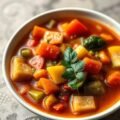Jamie Oliver’s Vegetable Curry is a vibrant, wholesome dish that’s all about celebrating fresh veggies with bold, warming spices. It’s not your typical curry loaded with heavy cream or too much oil. Instead, it’s a fresh, lighter take that still packs a flavorful punch. Jamie’s version brings together a mix of vegetables, coconut milk and a rich blend of spices to create a comforting, hearty meal that’s perfect for any time of year.
What really stands out is how approachable it is. This recipe feels welcoming. The curry is flexible, too-jam-packed with veggies but you can swap or add whatever you like depending on the season or what you’ve got in the fridge. It’s a dish that not only tastes great but also feels good to eat because it’s full of natural ingredients and vibrant flavors.
Jamie Oliver Vegetable Curry Recipe
Ingredients Needed
To make Jamie Oliver’s Vegetable Curry, here’s what you’ll need:
- Fresh Vegetables: Think carrots, potatoes, sweet potatoes, cauliflower, green beans, peas and sometimes spinach or kale. Jamie often suggests seasonal vegetables, so feel free to adjust.
- Onion and Garlic: The base aromatics that add sweetness and depth.
- Fresh Ginger: This gives the curry a zesty warmth.
- Curry Powder or Garam Masala: Jamie’s recipe often mixes spices like cumin, coriander, turmeric and chili powder for that classic curry flavor.
- Canned Tomatoes or Tomato Puree: Adds acidity and richness.
- Coconut Milk: Creamy and smooth, this balances the spices and adds a luscious texture.
- Chickpeas: For protein and a little bite.
- Fresh Coriander (Cilantro): For that fresh, herbal finish.
- Lemon or Lime Juice: Just a squeeze at the end brightens the whole dish.
Every ingredient works in harmony, building layers of flavor without overpowering the natural taste of the vegetables.
Equipment Needed
No fancy gadgets here! You just need:
- A Large, Heavy-Bottomed Pan or Pot: To cook the curry evenly without burning.
- A Sharp Knife and Cutting Board: For chopping your veggies and aromatics.
- Wooden Spoon or Spatula: To stir without scratching your pan.
- Measuring Spoons: To get the spices just right.
- Can Opener: For tomatoes and chickpeas.
That’s about it. Simple tools for a simply brilliant curry.
How To Make Jamie Oliver’s Vegetable Curry
- Prep the Veggies: Peel and chop your potatoes, carrots, cauliflower and any other veggies into bite-sized pieces. Finely chop the onion, garlic and ginger.
- Cook the Base: Heat some oil in your pan and sauté the onions until soft and translucent. Add garlic and ginger, stirring until fragrant.
- Add Spices: Toss in your curry powder or garam masala. Toast the spices gently for a minute or two. this unlocks their aroma and flavor.
- Build the Curry: Pour in canned tomatoes and stir to combine. Let it simmer for a few minutes until it thickens slightly.
- Add Vegetables and Coconut Milk: Add your chopped vegetables and chickpeas. Pour in the coconut milk and enough water or vegetable stock to just cover the veggies.
- Simmer: Let everything bubble away gently. This is when the vegetables soak up all those lovely flavors. Cook until the veggies are tender but still have a little bite.
- Finish It Off: Stir in fresh spinach or kale if using, cook for another couple of minutes. Add a squeeze of lemon or lime juice and sprinkle chopped coriander on top.
Serve with rice or warm flatbreads and maybe a dollop of yogurt if you want a cooling touch.
What I Learnt

Making Jamie Oliver’s Vegetable Curry taught me a few key things. First, simplicity and freshness can make a huge difference. You don’t need dozens of ingredients or complex steps to create a satisfying meal. Just fresh veggies, a good spice mix and patience.
Second, the importance of layering flavors stood out. Toasting spices, simmering tomatoes and cooking veggies gently made the curry vibrant and balanced. It’s a gentle process, not rushed, that makes all the difference.
Finally, the flexibility amazed me. This curry isn’t set in stone. It invites creativity-swap veggies, adjust spice levels, add lentils or tofu. It’s a recipe that grows with your tastes and pantry.
Recipe Tweaks For Jamie Oliver’s Vegetable Curry
Jamie Oliver’s vegetable curry is a fantastic base. It’s vibrant, fresh and packed with flavor. But tweaking it can take it to the next level, tailored to your taste or what you have on hand.
First off, spice levels. Jamie tends to keep it accessible but if you love heat, don’t hold back. Add extra chili-fresh green chilies, dried flakes or even a dash of cayenne. If you prefer mild, swap out the chili for smoked paprika for a smoky warmth without the burn.
Next, texture variations. Jamie’s curry often uses soft, stewed veggies. To add crunch and contrast, toss in some toasted cashews or almonds at the end. Or stir in some lightly steamed broccoli or snap peas for that satisfying bite.
Then there’s the protein game. While the original is veg-only, feel free to boost it up with chickpeas, lentils or even paneer cubes. These absorb the curry sauce beautifully and make the dish more filling.
Herbs and aromatics are key too. Jamie uses coriander liberally but why not try fresh mint or basil for a twist? A squeeze of lime or lemon juice right before serving can brighten everything up and add a tangy edge.
Finally, play around with the base ingredients. Coconut milk gives creaminess but you can substitute with almond milk or yogurt for a different flavor profile and texture. Or skip the creaminess and go with a tomato-based sauce for a lighter, sharper curry.
Storage Tips For Leftovers
Curry leftovers are like gold-often tasting even better the next day. But storing them properly makes all the difference.
First, cool the curry completely before storing. Hot food in the fridge can raise the temperature and risk spoilage. Divide your curry into airtight containers for quick cooling and easy portioning.
In the fridge, your vegetable curry will keep well for about 3-4 days. When reheating, add a splash of water, stock or coconut milk to bring back the saucy consistency. Curries tend to thicken in the fridge, so a little liquid helps revive the texture.
If you want to keep it longer, freezing is your best bet. Use freezer-safe containers or bags and leave some space because the curry will expand when frozen. Frozen vegetable curry can last up to 3 months. Thaw it overnight in the fridge and reheat gently on the stove or microwave.
Pro tip: If you’re freezing, avoid adding fresh herbs before freezing. Instead, add fresh coriander or mint right after reheating to keep their brightness intact.
What To Eat With Jamie Oliver’s Vegetable Curry?
This curry is versatile and pairing it well can elevate your meal.
The classic choice is rice. Basmati rice with its fragrant aroma pairs perfectly. For a nuttier twist, try brown rice or wild rice blends. If you want something quick, jasmine rice or even instant rice works well.
Naan bread or chapati is another amazing companion. The soft, pillowy texture of naan is great for scooping up the curry sauce. You can even toast the bread with garlic butter for an extra punch of flavor.
For a lighter side, consider a simple cucumber raita-yogurt mixed with grated cucumber, mint and a pinch of cumin. It cools down the spices and adds creaminess.
If you want to add crunch and freshness, a side salad with chopped tomatoes, onions and a squeeze of lemon is perfect. Or roast some cauliflower or sweet potatoes for a hearty, comforting combo.
Finally, for drinks, a cold mango lassi or a light, crisp white wine complements the flavors beautifully.
FAQs
What Vegetables Are Best For Jamie Oliver’s Vegetable Curry?
Jamie suggests using a mix of root vegetables like carrots, sweet potatoes, and parsnips, along with greens like spinach and cauliflower.
Can I Make Jamie Oliver’s Vegetable Curry Vegan?
Yes! Simply skip any dairy-based ingredients and use coconut milk for creaminess.
How Long Does It Take To Cook Jamie Oliver’s Vegetable Curry?
It usually takes around 40-45 minutes to cook, depending on how big your vegetable chunks are.


